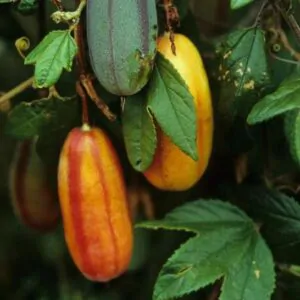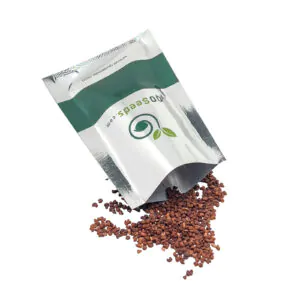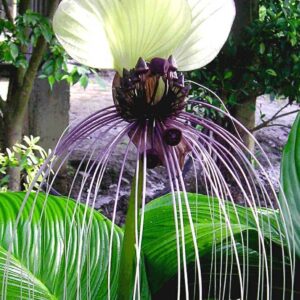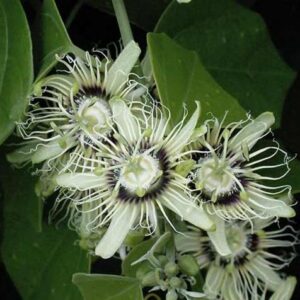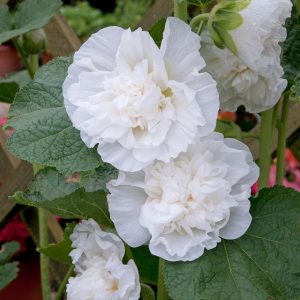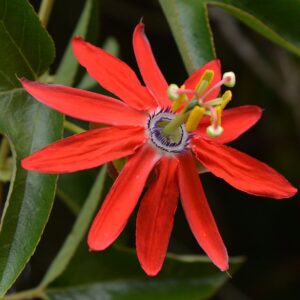/ per pack
Choose seeds per pack:
Botanical nomenclature: Clitoria ternatea var. ternatea
Common name: Blue Single, Butterfly Bea, Blue Pea, Kordofan Pea, Cordofan Pea, Asian Pigeon
Family: fabaceae
Origin: tropical equatorial asia, thailand and malaysia
Height: 4 meters
Brightness: full sun, partial shading
A very attractive species because of its hanging blue flowers, which makes it loved by horticulturists and landscapers. The standard petal with yellow markings in this species grows and enlarges to a beautiful fold which makes it eye-catching. Some varieties produce white flowers.
Description
Perennial, climbing herbs. Stems fine, twining, sparsely pubescent, and suberect at the base, 0.5–3 m long. Leaves pinnate with 5 or 7 leaflets; petioles 15–30 mm long; stipules persistent, narrowly triangular, 1–6 mm long, subulate, prominently 3-nerved; rachis 2–14 mm long. Flowers are axillary, single or paired in a raceme, about 40 mm long by 30 mm wide, consisting of a standard, wing petals and a keel; colour ranges from white, mauve, light blue to dark blue. Pods are linear-oblong, flattened, 40–130 × 8–12 mm, with margins thickened, and style persistent, sparsely pubescent when mature, pale brown, dehiscent when dry. Seeds 8–11 per pod, oblong, somewhat flattened, 4.5–7 × 13–4 mm, olive brown to almost black, shiny, often mottled, minutely pitted.
Conservation Status
Clitoria ternatea L. var. ternatea has not been evaluated for the Red List of South African plants.
Distribution and habitat
It is native to Africa, in these countries: Angola, Angola, Benin, Burundi, Cabinda, Cameroon, Cape Verde Is, Chad, Djibouti, Ethiopia, Gabon, Ghana, Guinea, Guinea Bissau, Ivory Coast, Kenya, Malawi, Mali, Mozambique, Nigeria, Sao Tome, Sao Tome & Principe, Senegal, Sierra Leone, Somalia, South Africa, Sudan, Tanzania, The Gambia, Togo, Uganda, Zaire, Zambia, Zimbabwe. Indian Ocean: Mauritius. Introduced: now widespread throughout humid and sub-humid lowlands of Asia, the Caribbean, Central and South America, and more recently in semi-arid (600–800 mm rainfall) tropical Australia. Southern Africa: Namibia, Gauteng and Mpumalanga. It grows as a vine or creeper, in moist, neutral soil at altitude of 185–610 m.
Derivation of name and historical aspects
The genus name Clitoria, is taken from the Latin, meaning ‘from a human female genital clitoris’. The genus was given this name because of its flower shape that resembles a clitoris. There were many discussions among botanists as to the appropriateness of the name. Names like Vexillaria and Nauchea were proposed, but they were never really used. To date, Clitoria is still the valid and accepted name for the vine. The genus has about 30–40 species in the tropics and subtropics of both hemispheres.
Ecology
Clitoria is a genus of insect-pollinated flowering plants. It is attractive to bees, butterflies and/or birds. It grows in a wide range of soil types (from sands to heavy clays) of moderate fertility, but is extremely well adapted to heavy clay alkaline soils, and especially on clay soils. The species adapts to pH 4.5–8.7, but prefers a medium to high pH. It grows best in rainfall of between 700–1 500 mm AAR and grows successfully with grasses.
Uses
Clitoria ternatea has multiple uses which include the following:
Food: the most used part in food is the flower. In Southeast Asia and Malasia,the flowers are used to colour food. In Thailand, they use the flowers to make a syrup blue drink called nam dok anchan and this drink is sometimes consumed with a drop of sweet lime juice to increase acidity and turn the juice into pink-purple. In Burmese and Thai cuisines, the flowers are also dipped in batter and fried.
Medicine: in traditional Hindu system of medicine, it is ascribed various qualities including, memory enhancing, antistress, anxiolytic, antidepressant, anticonvulsant, tranquilizing, and sedative properties. In traditional Chinese medicine, due to its appearance, similar to the female reproductive organ, it was used traditionally in an attempt to treat sexual ailments, such as infertility and gonorrhea, to control menstrual discharge, and also as an aphrodisiac.
Horticulture: it is grown as an ornamental plant, trained on an arbor or chain link fence. It also looks great in a hanging basket. It is used as a revegetation species (e.g., in coal mines in Australia), requiring little care when cultivated. It can be grown with elephant grass (Pennisetum purpureum ), and forage sorghums (Sorghum bicolor) and millets as well as Panicum maximum. Also sown with pangola (Digitaria eriantha ) as a pasture, and Andropogon gayanus and Dichanthium aristatum.
Nitrogen fixation: this plant is also used to improve soil quality through the decomposition of nitrogen rich plant material.
Growing Clitoria ternatea var. ternatea
Grow this vine in full sun. For the best results, water regularly. The species tends to get leggy quickly, so pinch often to induce bushiness. Flowers develop 4–6 weeks after sowing and can occur throughout the year given sufficient soil moisture and frost-free conditions. Fertiliser is not required when sown on suitable soils, only on infertile soils.
Propagate by seed or cuttings. Nick or file the seeds, then soak overnight in room temperature water before planting. Sow directly in the garden with 3–4 inch spacing when the soil warms in the spring. Seeds will germinate in 1-2 weeks. Cuttings root easily in moist sand or vermiculite.
These are the fungal leaf diseases reported on Clitoria ternatea:Cercospora, Colletotrichum, Odium and Rhizoctonia. Although tolerant of most insects, leaves are eaten by catterpillars and grasshoppers.
